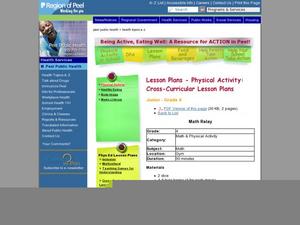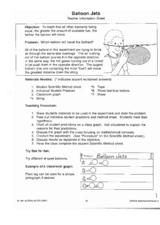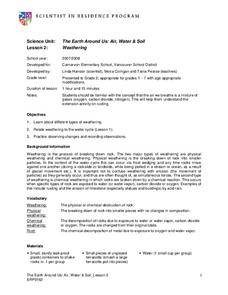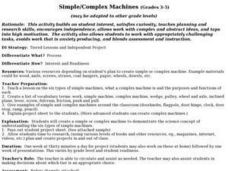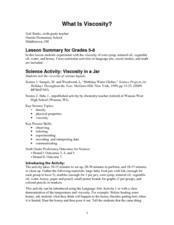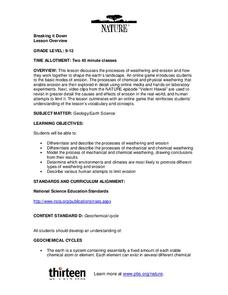InTouch
Warm-up and Cool-down Activities
What fun! Try out some of these PE warm-up and cool-down activities with your youngsters. Find several ideas written out along with tips to designing an effective warm-up or cool-down with elementary schoolers.
Curated OER
Golf
Are you starting a unit on golf in your physical education class? An outline for the entire unit includes daily lessons, warm-up activities, a quiz, and all the many basic aspects of playing a game of golf. Look through this resource and...
Missouri Department of Elementary
My Feelings
Encourage self-awareness with a lesson that challenges scholars to identify feelings—happy, sad, mad, and scared. Using a feelings thermometer, similar to that of a bar graph, pupils discuss how they would feel in specific scenarios then...
Foundation for Water & Energy Education
How is Flowing Water an Energy Source? Activity B
Explore the world's water without leaving the classroom! In this second of three uncomplicated but wonderful activities, physical science learners feel the pressure of water. They discover that the deeper the water, the stronger the...
Cornell University
Buoyancy
Swimmers know to float by turning their bodies horizontally rather than vertically, but why does that make a difference? In an interesting lesson, scholars explore buoyancy and the properties of air and water. They test cups to see which...
Curated OER
Snack Smart Move More
Show your kids that staying healthy is the smart choice! They examine nutrition, healthy snacks, and the importance of staying active in a several-part lesson plan. There are different ideas for older and younger students here, and you...
Curated OER
Math Relay
This is really a math review for older elementary learners to practice making equations using adding, subtracting, multiplying, and dividing in a fun way. They get to move around and play with hula hoops, bean bags, balls, and jump...
Curated OER
Balloon Jets
Students investigate how fuel amount affects the distance traveled by balloons. In this physics activity, students collect data and create a pictograph. They interpret data and formulate a conclusion.
Curated OER
Weathering
Second graders explore weathering and how the water cycle plays a part in weathering. In this weathering activity, 2nd graders put gravel and sugar cubes in a jar and shake, simulating weathering. Students use the scientific method...
Curated OER
Maps and Globes: Where in the World are We?
Students explore maps and globes. In this introduction to map and globe concepts lesson, students identify features of physical maps, political maps, and globes. Students locate land and water, and recite a poem about the names of the...
Curated OER
Don’t Sit Under the Apple Tree…You Might Become Famous
Students explore Newton's laws using CEENBoTs. In this physics instructional activity, students collect data and create tables and graphs. They calculate speed, acceleration and forces using mathematical formulas.
Vermilionville
Mardi Gras Elementary
You don't have to visit Vermilionville to experience the Cajun traditions of Mardi Gras. After examining pictures and hearing stories about these colorful traditions, learners create their own Courir de Mardi Gras masks.
Curated OER
Investigating Chemical and Physical Changes
Students explore physical and chemical changes by looking at how different powders react to a variety of substances. They observe and identify the difference between physical and chemical change using a mystery powder.
Curated OER
Are We Couch Potatoes or Busy Bees? Data Analysis of Physical Activity in School
Learners study practical data analysis within the constraints of the scientific method. In this data activity students collect and enter data into a computer spreadsheet then create graphs.
Curated OER
Melodies and Math: Creating Music with Non-Traditional Instruments
Review the 4/4 and 2/4 time signatures in music with a helpful music theory lesson plan. Young musicians experiment with electronic sounds and create their own musical performance using instruments made from materials found in the...
Curated OER
Poetry for the Elementary Classroom
Use Shel Silverstein's poem "Batty" to introduce poetry to young readers. This lesson is not formatted well, but the plan does suggest learners memorize a poem, recite the poem individually, and then recite the poem as a class. Poetry...
Scholastic
Study Jams! The Moon
Take your class to the moon and back with this compact slide show. A mix of computer-generated images and photographs are supported by explanatory text. Observers learn about the moon's movements, its physical features, and its phases....
Curated OER
Where Are The Dinosaurs?
Students examine the concept of extinction in relationship to the dinosaurs. In this elementary science lesson students become familiar with dinosaurs and that they are extinct. Students differentiate between different types of dinosaurs.
Curated OER
Simple/Complex Machines
Students make a simple machine. For this physics lesson, students learn about six types of simple machines and the purpose of each and brainstorm examples of simple and complex machines in the classroom. Students create a simple or...
Laboratory for Atmospheric and Space Physics
Jupiter’s Relative Size
How do you properly illustrate the extreme size difference between two planets—Earth and Jupiter? With the help of jellybeans, of course! Create a scale model of Jupiter's mass compared to Earth using a fishbowl, 1,400 beans, and a...
Institute of Electrical and Electronics Engineers
Keep it Cool
This cool lesson plan is ideal for elementary engineers or physical scientists, especially when learning about heat transfer and insulation. After reading a page of background information, engineering teams collaborate to design and...
Together Counts
Foundations of Wellness
You may be physically healthy, but what about mentally and emotionally? How is your social health? Kindergartners and first and second graders learn about the importance of maintaining their health in all aspects of their lives with a...
Curated OER
What Is Viscosity?
Learners experiment with the visocosity of corn syrup, mineral oil, vegetable oil, water, and honey. They research viscosity before beginning. Pupils draw the conclusion that the marble sinks more slowly in the liquids with greater...
PBS
Breaking it Down
After challenging themselves to correctly choose the form of erosion and length of time required for a given landform to develop, earth science class members model mechanical and chemical weathering with various lab demonstrations over...








